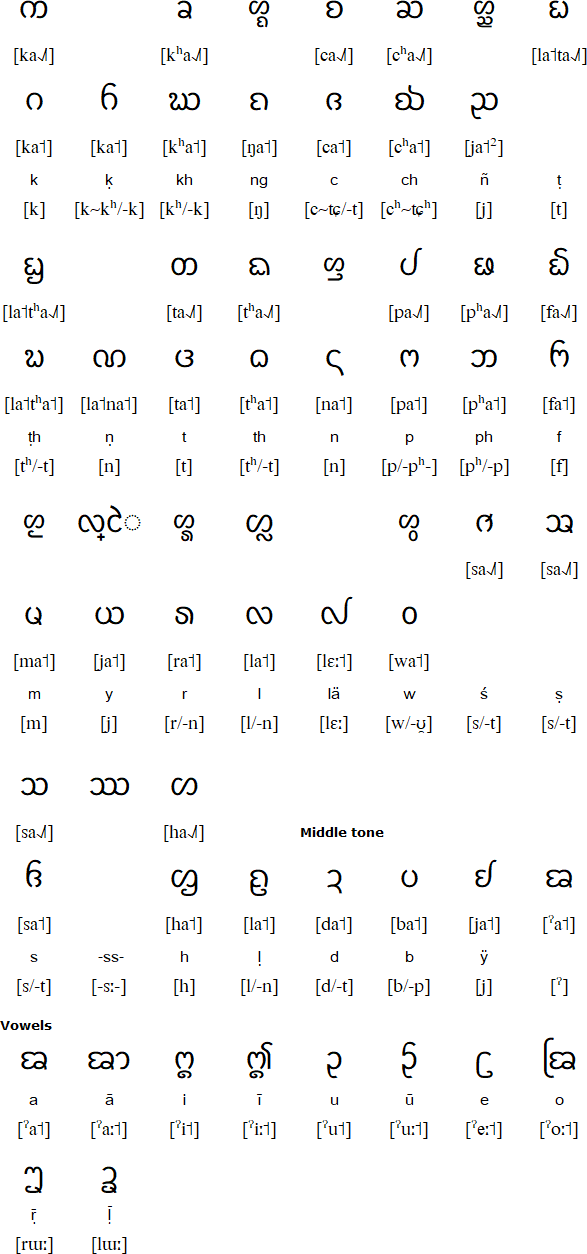Khün is a member of the southwesetern Tai branch of the Kra-Dai or Tai-Kaidai language family. It is spoken in mainly eastern Myanmar, and also in southern China, northern Laos and northern Thailand by about 116,880 people.
In Myanmar Khün is spoken in the Kentung area (ကျိုင်းတုံ) of eastern Shan state, and there were about 100,000 speakers in 1990. There were about 10,000 speakers of Khün in parts of Yunnan province in southern China in 1999. In Thailand there were abtou 6,280 Khün speakers in Chiang Mai and Chiang Rai provinces in 2000. In Luang Prabang Province of Laos there were about 600 Khün speakers in 2003.
Khün is also known as Tai Khün, Gon Shan, Hkun, Khuen, Khun Shan, Kengtung Dai or Kengtung-Hsipaw Shan. The native name for the language is ᨴᩱ᩠ᨿᨡᩨ᩠ᨶ [táj kʰɯ̌ːn]. It is closely related to Thai and Lao.
Khün has been written with a version of Tai Tham (Lanna) script since the 13th century. In Myanmar about 95% of male Khün speakers, and 50% of female Khün speakers can read and write their language. Most people learn to read and write Khün at their local temples in classes arranged by the Khuen Cultural and Literature Committee. There is also some instruction in families.

The Khün letters in the first row are in the high tone class, the ones in the second row are in the low tone class.
Details of the vowel and consonant diacritics can be found in this pdf, which was provided by Wolfram Siegel.
Download an alphabet chart for Khün (Excel)

Uncle Kaew and Auntie Kham Uhy have three children. The eldest child is called Jai Saeng, the middle one Jai Yort and the youngest Nang Daeng. They all three siblings together help their elderly parents by digging the field and ploughing the garden, collecting the vegetables and going to sell them in the city market. Then they buy rice, chillies and salt and bring them back to their parents' house like this every day without fail.
Source: A Description and Linguistic Analysis of the Tai Khuen Writing System
ᨾᨶᩩᩔ᩼ᨴ᩠ᨦᩢᩉᩖᩣ᩠ᨿᨠᩮ᩠ᨯᩨᨾᩣᨾᩦᨻ᩠ᨦᩈᩁᩓᩢᨹ᩠ᨿ᩵ᨦᨻ᩠ᨿᨦᨠ᩠ᨶᩢ ᨶᩱᨠᩥᨲ᩠ᨲᩥᩈ᩠ᨠᩢ ᩓᩢᩈᩥᨴ᩠ᨵᩥ ᨲ᩵ᩣ᩠ᨦᨣᩳ᩶ᨣᩢᨾᩦᨾᨶᩮᩣᨵᨾ᩠ᨾ᩼ᩓᩢ ᨣ᩠ᩅᩁᨷᨭᩥᨷ᩠ᨲᩢᨲᩳ᩵ᨠ᩠ᨶᩢᨯᩢ᩠ᩅ᩠ᨿᨣ᩠ᩅᩣ᩠ᨾᨹ᩠ᨿ᩵ᨦᨻ᩠ᨿᨦᨠ᩠ᨶᩢ
All human beings are born free and equal in dignity and rights. They are endowed with reason and conscience and should act towards one another in a spirit of brotherhood.
(Article 1 of the Universal Declaration of Human Rights)
Source: https://unicode.org/udhr/d/udhr_kkh_lana.html
Information about Khün language
https://en.wikipedia.org/wiki/Khün_language
https://www.ethnologue.com/language/kkh
https://evols.library.manoa.hawaii.edu/bitstream/10524/52403/1/09_Owen2017description.pdf
Ahom, Aiton, Bouyei, Isan, Kam, Khamti, (Tai) Khün, Lao, Lue, Northern Thai (Kam Mueang), Nùng, Shan, Sui, Tai Dam, Tai Dón, Tai Hongjin, Tai Laing, Tai Nuea, Tai Phake, Tai Ya, Thai, Thai Song, Yang Zhuang, Zhuang
Page last modified: 15.07.22
[top]
Why not share this page:

If you like this site and find it useful, you can support it by making a donation via PayPal or Patreon, or by contributing in other ways. Omniglot is how I make my living.
Note: all links on this site to Amazon.com, Amazon.co.uk
and Amazon.fr
are affiliate links. This means I earn a commission if you click on any of them and buy something. So by clicking on these links you can help to support this site.
Get a 30-day Free Trial of Amazon Prime (UK)
If you're looking for home or car insurance in the UK, why not try Policy Expert?
[top]